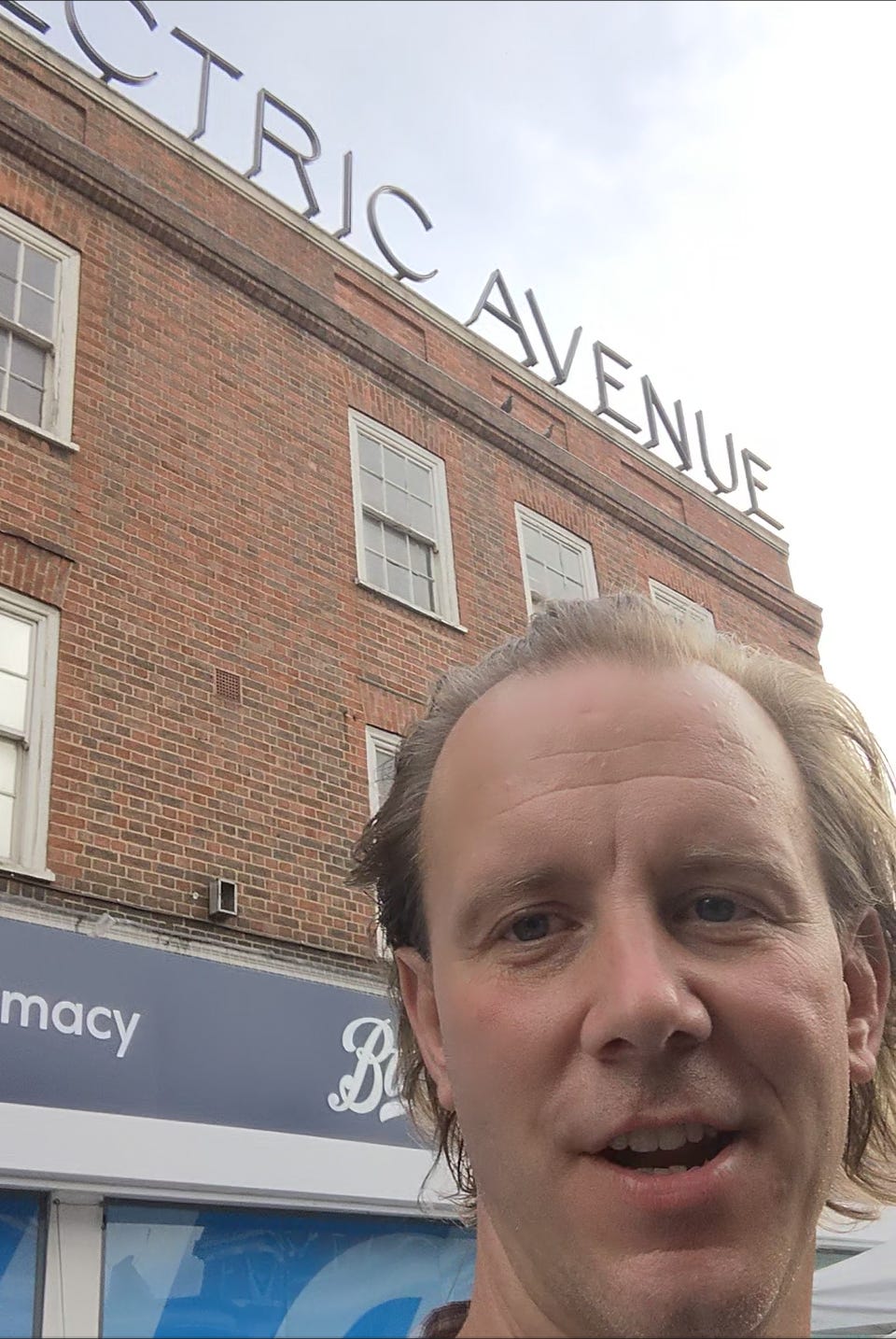Why They Were Out in the Streets of “Electric Avenue”: The Brixton Riots and the Ongoing Persecution of the Windrush Generation
Trump Might Have Won the Election, But Eddy Grant Remains Undefeated
On September 15th, 2024, Judge John Koetl of the Southern District of New York federal district court held that Donald Trump must cease and desist from using Eddy Grant’s hit “Electric Avenue” at campaign rallies, and take down a twitter video with 13.7 million views featuring the song. The case’s key exhibit is actually from the 2020 campaign, where the Trump campaign created a cartoon of a “Trump / Pence” train speeding by a sickly old Joe Biden in a railroad cart, set to 40 seconds of “Electric Avenue.”
In its context, using “Electric Avenue” as a Donald Trump warm-up anthem isn’t just a nostalgia play: It’s an aggressive appropriation of Black protest music designed to tame its original meaning. For starters, Eddy Grant’s hit intersects:
1) The Brixton Riots of the 1980s in the bombed-out slums of southern London,
2) “Operation Swamp 81” and the current-sounding but actually Victorian “Sus Law,”
3) London Metropolitan Police abuses that eventually got their version of “Stop and Frisk” rescinded by Parliament,
4) The “Windrush Generation” of Afro-Caribbean immigration during the post- World War II liquidization of the British Empire,
5) David Bowie making original MTV VJ Mark Goodman flop-sweat during the early days of basic cable,
6) The most racist policy of the Theresa May prime ministership that cost her Home Secretary her job, and
7) The best street-vendor jerk chicken outside the Caribbean.
A little personal context upfront.
(The author on his first trip to Brixton, June 2016)
In the early 90s, I worked in the menswear department at Montgomery Ward, next to "Electric Avenue." You remember the commercials: the cheapest stereos and tvs in the mall! I heard that song once every 20 minutes, a full dozen times during a 4 hour evening shift. Just rockin' out while folding sweaters for $5.25 an hour, across from Electric Avenue.
(The author in October 2024, in the West Bottoms of Kansas City, next to an abandoned warehouse with a Montgomery Ward Electric Avenue semi trailer that has to have been there for at least 25 years)
That kind of exposure ear-worms a song deep into your psyche. So, on one of my first trips to London, I went to see the real Electric Avenue. It’s not hard to find: around the corner from the Brixton tube station at the south end of the Victoria Line.
Exit the station, directly across the street, look at the lefthand wall in the alley, and you'll see the David Bowie Mural–this is a key detail we’ll return to. Back at Brixton Station, exit, turn left, go one block, look up at the roof of the Boots Pharmacy, and you'll see the Electric Avenue sign.
(That’s me after 20,000 steps in a very windy London on Electric Avenue, June 2023)
In the 1880s, this street was the first in London to be lit by electricity. Long story short, over the century, Brixton became home to many Caribbean immigrants (still today, Brixton has one of the largest Jamaican populations in the world), many of whom migrated as part of the "Windrush Generation" after World War II. The Windrush Generation was a huge migration wave from the West Indies, mostly people of Afro-Caribbean descent, moving to the United States, United Kingdom, Canada, and other English-speaking realms. They spoke English, of course, as a legacy of the British Empire, and that’s why today, the largest Caribbean festival in North America occurs every August in Toronto on the lakefront: Caribana, one of the most colorful, chaotic parties in the western hemisphere.
Taking us back to London, as part of the post-WWII unwinding of the Empire, the 1948 British Nationality Act granted Commonwealth citizens Right Of Entry to the UK. The Windrush Generation mostly settled in Brixton, a neighborhood south of the Thames that grew up after the building of Vauxhall Bridge in 1809. Brixton was bombed out badly by the Germans during the War, creating a neighborhood of substandard housing that eventually led to "slum clearances" in the 1960s and 70s. The neighborhood had become one of the most multi-cultural in London, a combination of white working class and Caribbean first and second generations---with a reputation for being a music and artists colony because of the cheap and available real estate.
By the 1980s, racial tensions heightened, and the police began to employ the 1824 Vagrancy Act, the so-called "Sus Law,” which authorizes the police to arrest anyone for “acting suspiciously” with the “intent to commit an arrestable offense.” Though this law dates to the pre-Victorian age, the concept is very similar to the 1968, judicially-created "Terry Stop" exception to the 4th Amendment. By the 1980s, the LMP’s use of Terry Stop-style tactics had grown into systematic, aggressive targeting of non-white men throughout the multicultural boroughs of London.
In the United States context, the LMP’s “Sus Law” tactics are largely indistinguishable from what later became known as “Stop and Frisk.” This extreme version of Terry Stops were widely deployed as by the NYPD during the Bloomberg administration–-which were declared unconstitutional in 2013 because they disproportionately targeted Black and Latino men. There’s plenty of evidence to suggest that the NYPD learned “Stop and Frisk” from the aggressive ethnic profiling by European police, most notably in Brixton, Tottenham, and other London neighborhoods during the slum clearances.
On April 10-11, 1982, things boiled over, and hundreds of London Metropolitan Police and young Black men fought in the streets of Brixton--mostly over the issue of aggressive policing. The largest clash was called Bloody Saturday, though no deaths were reported.
Following the riots, the Thatcher government commissioned the Scarman Report, in which the Home Secretary appointed the very well respected “Law Lord” (basically, an appellate judge in the English system) Lord Leslie Scarman to produce a report on the causes of the riots, and recommendations for further action.
A self-proclaimed liberal, Lord Scarman oversaw official government inquiries into riots in Northern Ireland and the Red Lion Square riots by the fascist National Front movement. But this was also a Thatcher era commission, and Scarman had upheld conservative policies in other inquiries in which he presided. In short, Lord Scarman was a man to be taken seriously.
Scarman found that, yes, the Brixton Riots occurred in an environment of urban decline, and yes, racism was a primary factor that required “urgent action” to hasten “the very survival of our society.” More precisely, he found that the Metropolitan Police’s “Operation Swamp 81” had resulted in the “spontaneous” riot, largely putting the blame on the police, not the protesters.
Operation Swamp 81, ostensibly to combat “street crime,” took advantage of the “Sus Law” to stop, search, and jail thousands on the mere suspicion of violating the 1824 Vagrancy Act. Remember, you don’t have to have actually committed a crime, but merely “act” like you “intend” to commit one–in the judgment of the officer. Under the cover of this law, when the Metropolitan Police carried out Operation Swamp 81 in April of 1981, hundreds of plain-clothes officers flooded Brixton. Not only did they stop-and-search citizens, but set up roadblocks and mass detention facilities. There was no consultation with local authorities or officers, but reading the report, it feels like the Metropolitan Police carried out a para-military operation in the streets of Brixton.
This, dear readers, is what "Electric Avenue" is about. This is why Eddy Grant said "Now in the street there is violence...no place to hang our washing." The Windrush Generation from the colonies settled in a bombed out slum of south London, were largely unable to rebuild the neighborhood because subsequent British governments asked companies to stop recruiting Caribbean labor because it was "unsuitable," and eventually led to police riots.
But how did “Electric Avenue” itself become a hit? In 1983, contemporary to the riots, Brixton’s most famous pop star, David Bowie, was the first white musician to openly confront MTV about its lack of Black musicians in this incredibly awkward interview with original VJ Mark Goodman. Whatever else is true about David Bowie, David Bowie grew up in Brixton surrounded by the Caribbean community, so he understood the inherent racism in MTV’s video rotation. This context is still embedded in Brixton alleyways The Ziggy Stardust Mural is right around the corner from Electric Avenue.
(My picture of the Star Man Mural in July 2016, 6 months after Bowie’s death. People were still laying flowers and writing him messages like this)
Soon after, MTV responded to the criticism by including more Black artists in its programming. And what was one of the videos that became prominent in MTV's rotation, launching it as an enormous hit that still generates thousands in royalties?
"Electric Avenue" by Eddy Grant. Which he wrote after working at a theater in Brixton, then moving to Barbados, where the video was filmed.
If you take the long view of history, you might say Donald Trump's weird appropriation of Black music extends back to the sugar plantations of Jamaica, but maybe that's too much. In the very least, the story is firmly entrenched in the history of the British Empire--here, appropriating Black protest music, then gradually taming it over the years until it’s so divorced from its original context that it loses its meaning in the popular, white-defined consciousness.
It’s a common thing, Black protest music getting worm-brained into your skull, not to express outrage at injustice, but to sell stereos. Or get used as warm-up music by an 80s media guy turned aspiring dictator, promising mass deportations that will include the Americans of the Windrush Generation.
In fact, deportation of longstanding Windrush residents and citizens isn’t new to Trump: It was the biggest scandal of the Theresa May Prime Ministership, which eventually brought down her Home Secretary.
In 2018, the Theresa May administration instituted what was informally called the “Hostile Environment Policy,” targeted specifically at the Windrush Generation. Among other new burdens, it required longtime immigrants to prove that they resided in the UK before 1973, the last year of eligibility under the British Nationality Act. The government expressly sought to create a “hostile environment” for Caribbean immigrants, hoping they would “voluntarily leave.” Incidentally, Theresa May first announced this policy in 2012, around the same time as then-Republican presidential nominee Mitt Romney articulated his “self-deportation” immigration strategy.
To this day, we still don’t know how many Afro-Caribbean UK residents were affected, but there were enough people detained, kicked out of their homes, denied benefits and medical care that Home Secretary Amber Rudd was forced to resign. Passports were confiscated, and longtime Afro-Caribbean UK residents were denied entry back into the country, separating families across the Atlantic Ocean. Eventually, the government rescinded the policy and instituted a compensation scheme, but very few people have actually received their money, and at least 23 have died before getting paid.
If you stroll through Brixton, you’ll see a gentrifying London that’s representative of London today: People from cultures the world over, increasingly priced out by rising real estate prices. Visit Brixton Village, which is, yes, one of those outdoor markets increasingly popular in “emerging” parts of the city. Still, Brixton retains much of its Caribbean flavor, and you’ll find great jerk chicken (pictured below!). While you’re there, remember the victims of the Brixton Riots of 1983 and Eddy Grant, who memorialized the ongoing resistance out in the street of Electric Avenue.








